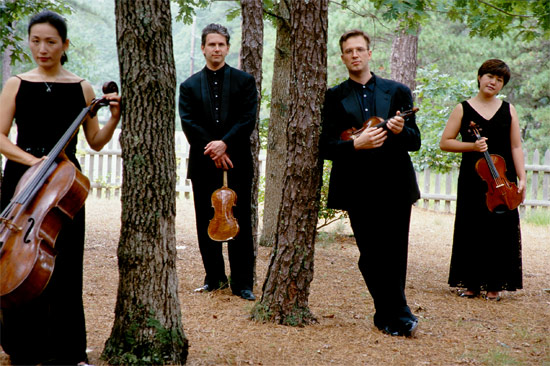Borromeo Quartet shows its Bohemian bona fides in music of Dvorak

The Borromeo String Quartet performed Sunday afternoon at the Gardner Museum. Photo: Susan Wilson
Locals think of them as Boston’s own, but the Borromeo String Quartet belongs to the world. And with the ongoing Dvorak Project, the group belongs to different musical eras as well. The project’s latest installment came Sunday afternoon at the Gardner Museum, when the foursome played the String Quartet in G major, Op. 106, and then were joined by cellist Paul Katz and violist Dimitri Murrath for the Op. 48, A major Sextet.
Through their longtime association with the New England Conservatory, the Living Archives online performance series, and annual mentoring residency each summer in Taos, Borromeo has established itself as a premier teaching ensemble. Complete performance cycles of the Beethoven and Bartok quartets, and now this extended exploration of Dvorak’s great chamber works, have furthered that reputation onstage.
This program featured a quartet from Dvorak’s most mature period—the G major was composed around 1895—and the A major sextet from a much earlier, but no less fruitful period, almost twenty years earlier. Both works offered substantial first movements, an almost orchestral approach to part writing, and some thrillingly dramatic moments.
Anchored by founding members Nicholas Kitchen (first violin) and Yeesun Kim (cello), Borromeo has now entirely blended the relatively newer contributions of second violinist Kristopher Tong and violist Mai Motobuchi into an impeccable ensemble sound. An unusually delicate opening to the G major quartet led into a distinguished, lengthy Allegro moderato first movement. Playing was crisp, the entire ensemble alert to gestural possibilities, full of swells of passion that subsided into pensive episodes.
The Adagio began with a martial figure, in the lower voices only at first, picked up by the second violin, and then finally after several measures by Kitchen as well. Intonation seemed strained throughout this movement (a lengthy tuning after the movement fixed that), but the cross-talk among the players was at the most sophisticated level. A long pause led to a reintroduction of the martial figure, revised and furthered harmonically, invigorated but still sounding ominous.
The third movement, a Rondo marked Molto vivace in B minor, featured a brisk dotted figure in its A section. The B section interlude was shaped by long phrases, lucidly brought out by the upper voices, before a brief but emphatic return to the opening. The finale had two personalities: a very brief Andante sostenuto, with a slow, descending scale etched out by Kitchen; and a call-and-response between inner and outer voices, marked Allegro con fuoco, played with alert distinction.
The quartet was joined by two NEC colleagues for the sextet: the venerable Katz, and the talented Murrath. They players sat as three pairs, similar instruments together, but this is a work for six discrete parts, not three instrumental sections.
The work pivots around the stately Dumka second movement. The opening, long and adventurous, had Kitchen, with remarkable consistent upper tone, leading the interaction. The Dumka (Poco allegretto), rather that the usual loud and soft alterations, shifted between staccato lines and extended, dance-like phrases. After a riveting Furiant third movement, the finale, a theme with five variations, entered with almost entirely different character.
The theme comes first from the violas, a lovely duet with cellos underpinning, the upper strings silent. The variations pass from first violin to cello to violin duet and back to first, before ending in a tutti exclamation. Apart from following the alternating variations, the interaction between the pairs of instruments proved most engaging, particularly Murrath and Motobuchi trading lines in the viola duets.
The next Sunday Afternoon at the Gardner presentation will feature A Far Cry with flutist Paula Robison 1:30 p.m. April 21.
Posted in Performances



